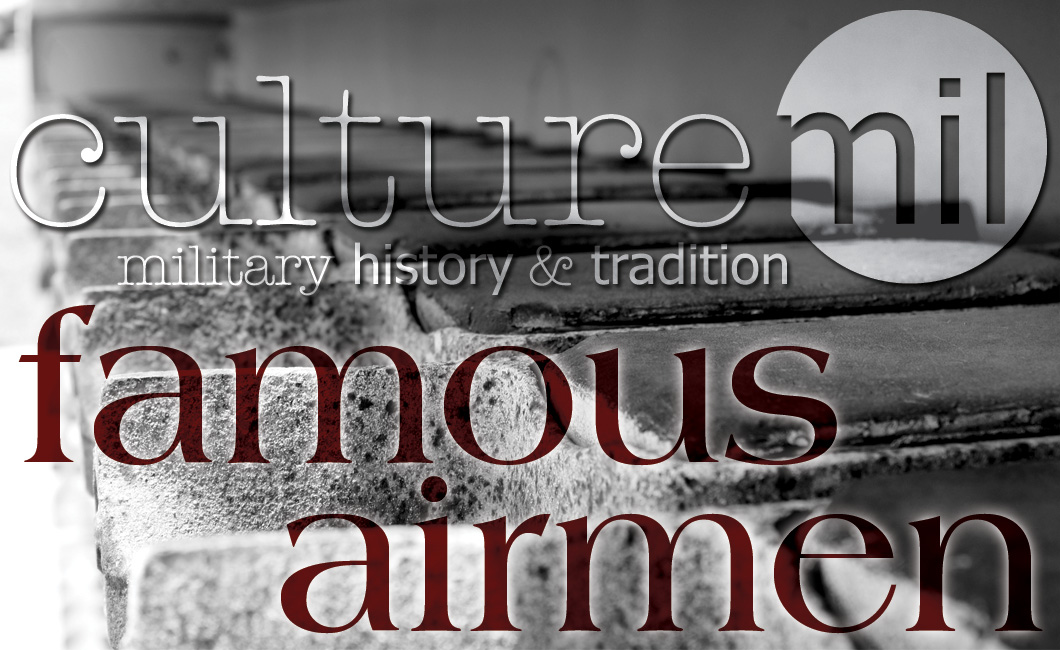- http://www.biography.com/people/groups/air-force
- https://en.wikipedia.org/wiki/List_of_United_States_airmen (*for a more complete list)
- http://blog.customink.com/2013/07/air-force-slogans-sayings/
- http://www.hill.af.mil/library/factsheets/factsheet.asp?id=5849
- http://www.jsc.nasa.gov/Bios/htmlbios/bluford-gs.html
- http://www.military.com/veteran-jobs/career-advice/military-transition/famous-veteran-chuck-norris.html
- http://www.lifetimetv.co.uk/biography/biography-chuck-norris
- http://www.cbsnews.com/pictures/stars-who-served-in-the-military/10/
- http://martialarts.about.com/od/martialartsculture/p/chucknorris.htm
- http://militaryhistory.about.com/od/airforce/p/rickenbacker.htm
- http://www.homeofheroes.com/wings/part1/4_aceofaces.html
Written by Jenifer Chrisman on July 25, 2016.
From astronauts to politicians, activists to actors, inventors to business leaders, they all had one thing in common…at one point or another in their lives they were United States Airmen. Some were famous before they joined. Some began to distinguish themselves during their service. And others became notable after.
Even though many were among the Army Air Force before the Air Force became its own branch on September 18, 1947, the Air Force’s notables strove to follow their current recruiting slogan, “Aim High.”
While much is lost over time, and some names have become nearly obscure, each in their own way made a contribution to the rank and file. They deserve to be recognized, not just for their fame, but for their service to this country. And while there are too many to name* them all, below is a list of fifty names, along with three short standout bios, of famous Airmen.
Guion Stewart “Guy” Bluford, Jr. (1942-) was the first black astronaut to fly in space. Born in Philadelphia, he received a Bachelor of Science degree (aerospace engineering) from Pennsylvania State University in 1964. After graduation he joined the U.S. Air Force. He attended pilot training and received his wings in 1966. He flew 144 combat missions in Vietnam, as well as serving as an instructor pilot and on staff positions, and has logged more than 5,200 hours of flight time. After the war he continued his schooling, earning a Master of Science degree (aerospace engineering) in 1974 and a PhD (major: aerospace engineering, minor: laser physics) in 1978 from the Air Force Institute of Technology. He left the Air Force as a colonel and joined the NASA astronaut class in 1979 as a mission specialist. He flew four times, logging more than 688 hours in space. His first mission in 1983 (STS-8) was not only the first time black astronaut flew in space, it was also the first nighttime launch and landing. His other three flights were STS 61-A in 1985, the German Spacelab mission STS-39 in 1991 and STS-53 in 1992. During his NASA career he earned a Master’s Degree in business administration from the University of Houston in 1987. Since 1993, after leaving NASA, he has worked in private industry. Guion Bluford’s list of special honors is extensive (www.jsc.nasa.gov). They include the National Defense Service Medal (1965), the Vietnam Service Medal (1967) and he is an International Space Hall of Fame inductee (1997).
Carlos Ray “Chuck” Norris (1940-), in preparation of a career in law enforcement, joined the U.S. Air Force as a military police officer after high school. While stationed in Korea he began studying Tang Soo Do and Tae Kwan Do, eventually becoming the first Westerner to be awarded an eighth-degree Black Belt (Tae Kwan Do). He left the Air Force in 1962 as an Airman First Class and began teaching martial arts full-time, including such notable names as Steve McQueen. Starting in 1968, Norris held the Professional World Full-Contact Middleweight Karate Champion title for six years. He also won the Triple Crown (highest number of tournament wins) and Fighter of the Year in Black Belt magazine in 1969. By the time he retired in 1974 he had established thirty-two karate schools. It was Steve McQueen who encouraged Norris to get into acting. Although he performed in many roles, he didn’t star in a movie until 1977. He gained critical acclaim in 1985 in “Code of Silence” and wrote his autobiography in 1988. But with the end of the 80s his appeal began to fade and he switched to television. He starred in and became executive producer of “Walker, Texas Ranger” (1993-2001), then returned to film in 2003. In between, Norris became an offshore powerboat racer, winning the championship in 1991, and set a new world record (12 hours, 8 minutes) racing across the Great Lakes from Chicago to Detroit (605 miles) in a Scarab boat. He works for a number of charities, including the Veterans Administration National Salute to Hospitalized Veterans, and became an Internet phenomenon and cult icon through “Chuck Norris Facts.” Along with film and television awards, Chuck Norris received the Golden Lifetime Achievement Award by the World Karate Union Hall of Fame in 2000 and Veteran of the Year award from the Air Force in 2001.
Edward Vernon “Eddie” Rickenbacker (1890-1973) was the son of Swiss immigrants who left school at the age of twelve, after his father’s death, to help support his family. His mechanical skills eventually led him to employment with Frayer Miller Aircooled Car Company and in 1910 he began racing his employer’s cars. He participated in the Indianapolis 500 four times, earned the nickname “Fast Eddie” and set a race speed record of 134 mph. Rickenbacker joined the U.S. Army wanting to be a pilot, but was assigned to be the personal driver of General John J. Pershing, commander of the American Expeditionary Force. After he requested to repair the car of Colonel Billy Mitchell, chief of the U.S. Army Air Service, he received his break and, despite being considered too old, was sent to flight school. After training he was retained as an engineering officer, but during his off hours was permitted to fly. Rickenbacker found himself a replacement and, receiving permission to his application, joined the 94th Aero Squadron in 1918. He scored his first victory on April 26 and achieved ace status after downing two Germans in one day on May 30. Rickenbacker was promoted to captain and placed in command of the squadron on September 24. He downed his twenty-sixth and final aircraft on October 30. After the war he started Rickenbacker Motors which, although driven out of business by larger companies, pioneered advances such as four-wheel braking. He purchased the Indianapolis Motor Speedway in 1927, upgrading the facilities and introducing banked curves. In 1938 he bought Eastern Air Lines, taking the small carrier to the national level and revolutionizing the operations of commercial airlines. Rickenbacker volunteered his services at the outbreak of World War II. He visited and assessed operations throughout various Allied bases in Europe at the request of Henry L. Stimson, Secretary of War. Rickenbacker had certainly faced death more than once as a pilot, but when an Eastern DC-3 crashed outside Atlanta in 1941 it took months for him to recover. And en route to deliver a secret message from Stimson to General Douglas MacArthur, his plane went down, leaving him and the rest of the survivors adrift for twenty-four days. Eddie Rickenbacker died on July 23, 1973. He received the combat achievement title “Ace of Aces” and held it for the remainder of World War I, beating out First Lieutenant Frank Luke (KIA) by eight kills. He also published his memoirs, “Fighting the Flying Circus,” in 1919, where he takes the reader inside the mind of a fighter pilot and recalls his occasional run ins with the “Flying Circus” of the “Red Baron,” Manfred von Richthofen.
50 FAMOUS AIRMEN
| Name | Occupation | Rank |
|---|---|---|
| Buzz Aldrin | Astronaut | Major General |
| Robert Altman | Director | Lieutenant |
| Gene Autry | Actor, Singer, Pro Baseball Team Owner | Flight Officer |
| Amiri Baraka | Critic, Scholar, Civil Rights Activist, Poet | Sergeant |
| Guion S. Bluford | Astronaut, Scientist, Pilot | Colonel |
| George W. Bush | U.S. Governor, U.S. President | First Lieutenant |
| Red Buttons | Actor, Comedian, Television Personality | Second Lieutenant |
| Johnny Cash | Guitarist, Songwriter, Singer | Staff Sergeant |
| Lee J. Cobb | Actor | Corporal |
| Jacqueline Cochran | Pilot | Colonel |
| Eileen Collins | Astronaut | Colonel |
| Michael Collins | Astronaut | Major General |
| Jackie Coogan | Actor | Flight Officer |
| Tom Daschle | U.S. Senator (South Dakota) | First Lieutenant |
| Jimmy Doolittle | Aviation Pioneer | General Air Force Chief of Staff |
| Robert M. Gates | 22nd United States Secretary of Defense | Second Lieutenant |
| Barry Goldwater | U.S. Representative | Major General |
| Peter Graves | Actor, Television Personality | Corporal |
| Gus Grissom | Astronaut | Lieutenant Colonel |
| Larry Hagman | Actor, Producer | Airman First Class |
| Don Ho | Singer | First Lieutenant |
| William Holden | Actor | Second Lieutenant |
| Daniel James Jr. | Fighter Pilot | General Air Force Chief of Staff |
| Lonnie G. Johnson | Engineer, Inventor | Captain |
| Tom Landry | Coach | First Lieutenant |
| George McGovern | U.S. Senator (South Dakota) | First Lieutenant |
| Robert S. McNamara | Government Official, Military Leader | Lieutenant Colonel |
| James Meredith | Civil Rights Activist | Sergeant |
| Clayton Moore | Actor | Corporal |
| Chuck Norris | Actor, Martial Arts Expert | Airman First Class |
| Ron Paul | U.S. Representative, Doctor | Captain |
| Rick Perry | Governor (Texas) | Captain |
| Gregg Popovich | Coach | Served |
| Lewis F. Powell Jr. | Supreme Court Justice, Judge | Colonel |
| Robin Quivers | Radio Talkshow Host | Captain |
| William Rehnquist | Supreme Court Justice | Sergeant |
| Eddie Rickenbacker | Business Leader, Race Car Driver, Pilot | Captain |
| Bob Ross | Painter, Television Personality | Master Sergeant |
| Roy Scheider | Actor | First Lieutenant |
| Neil Simon | Screenwriter, Playwright | Corporal |
| Arlen Specter | U.S. Representative, Lawyer | First Lieutenant |
| Jimmy Stewart | Actor | Brigadier General |
| Preston Sturges | Screenwriter, Director, Playwright | Second Lieutenant |
| Percy Sutton | Civil Rights Activist, Lawyer | Captain |
| Hunter S. Thompson | Author, Journalist, Activist | Airman First Class |
| Paul Tibbets | Military Leader, Commander of the Enola Gay | Brigadier General |
| George C. Wallace | Governor (Alabama) | Staff Sergeant |
| Thornton Wilder | Author, Playwright | Lieutenant Colonel |
| Flip Wilson | Actor, Comedian | Airman First Class |
| Chuck Yeager | Military Leader, Test Pilot | Brigadier General |
Sources:



